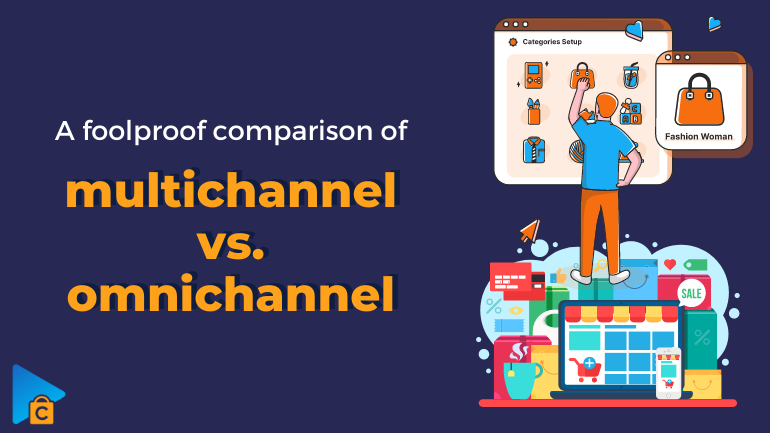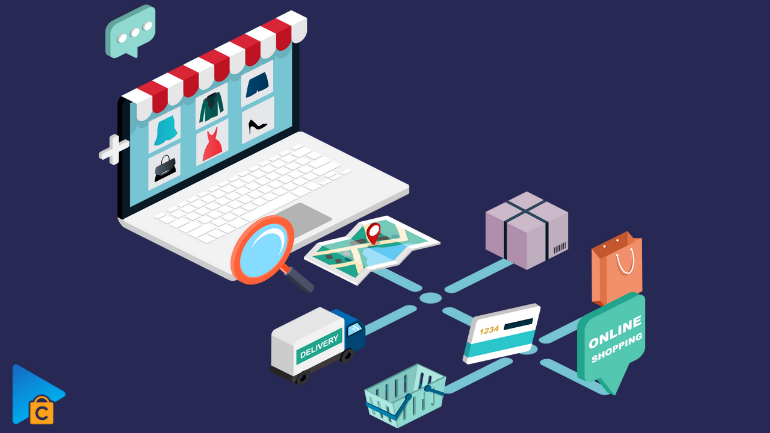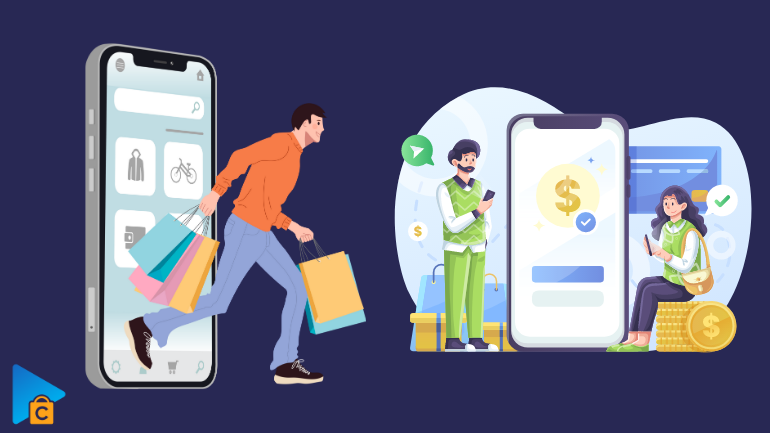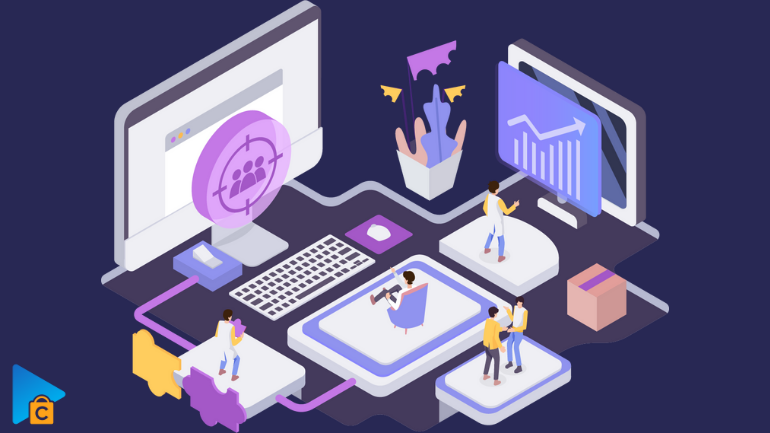
If you’ve been following online marketing trends, you might be familiar with the terms “multichannel” and “omnichannel.” While marketers commonly use both to refer to customer experience strategies, there is a distinction between them—a difference that could impact your company’s success.
In this blog post, we’ll explore the differences between multichannel vs. omnichannel customer experiences as well as discuss which strategy should be employed for more effective results. Keep reading to learn more about these two approaches to engaging customers at every stage of their buying journey.
- What is Multichannel?
- What is Omnichannel?
- Multichannel vs. Omnichannel: Differences
- While multichannel is more product-focused, omnichannel is more customer-focused
- While multichannel does not combine channels with one another, omnichannel retail directly connects channels to make them function together
- A multichannel strategy restricts the consumer experience to what is possible through each particular channel, but an omnichannel strategy creates new customer experiences
- Multichannel vs. Omnichannel Examples
- Omnichannel: A physical store displays information about an online product
- Click-and-collect services are omnichannel because they mix the convenience of online buying with in-store availability
- Multichannel: A company sells goods on its website, sends them to merchants, promotes them on Google and Facebook, and adds more goods to Amazon
- Apple’s multichannel strategy
- Amazon’s omnichannel success
- Multichannel and Omnichannel Marketing
- Multichannel vs. Omnichannel: Which is the Better Option?
- In sum,
What is Multichannel?
Multichannel is a business strategy that combines the customer experience and allows customers to participate via their chosen channel. It is flexible, but companies must adhere to the channel’s rules of conduct.
Imagine a wheel with spokes as a concept for multichannel marketing. Your merchandise is located at the wheel’s hub (i.e., a sale). Your clients are located on the outside rim of the wheel, where each channel provides a distinct and independent chance to make a purchase.
Once it’s obvious which channels most appeal to your target demographic, you can focus your marketing efforts there to increase sales.
What is Omnichannel?
Omnichannel is an online sales approach that gives customers a seamless buying experience across channels. Omnichannel enables retailers to sell across various channels, including PCs, mobile devices, and physical storefronts.
It involves communicating in ways that align with why they utilize a particular channel and demonstrating an understanding of their unique stage in the customer lifecycle.

Customers may make purchases wherever they are because omnichannel technology considers channel spillover and provides seamless customer experiences across all channels instead of treating them as separate, autonomous silos.
To put it simply, omnichannel blurs the borders between various sales and marketing channels to provide a smooth, integrated whole. With the emergence of a single consumer standpoint and a single shopping experience, the boundaries between channels—onsite, social, mobile, email, physical, and instant messaging—disappear.
Multichannel vs. Omnichannel: Differences
The focal point of your marketing plan is the main distinction between multichannel vs. omnichannel. While multichannel refers to using more than one channel and is oriented around the product or service, omnichannel refers to using all available media channels and focusing on customers.
While multichannel is more product-focused, omnichannel is more customer-focused
A key component of an omnichannel strategy is recognizing all points of contact a consumer has with a brand and figuring out how to take advantage of those interactions to improve the customer’s convenience and commitment to the company.
On the other hand, businesses use a multichannel approach to reach as many valued consumers as possible with their products. Still, the focus is mostly on growing their online presence rather than improving the customer experience.
While multichannel does not combine channels with one another, omnichannel retail directly connects channels to make them function together
The term “omnichannel retail” often describes how physical storefronts and an organization’s internet activities coexist. Meanwhile, multichannel retail is also defined as having both physical shops and online stores. However, the activities are not integrated into the broader business but rather are divided into distinct channels.
While omnichannel marketing creates interactions on different channels to optimize the customer journey at each touchpoint, multichannel marketing works on multiple channels with the same content or unrelated content.
A multichannel strategy restricts the consumer experience to what is possible through each particular channel, but an omnichannel strategy creates new customer experiences
By combining the capabilities of many channels, businesses may provide novel and memorable customer experiences that customers wouldn’t typically get from a single channel.
Between multichannel vs. omnichannel, a multichannel strategy makes it easier for customers to identify the items they desire and allows them to buy on platforms they are already familiar with. Still, the brand exposure is only available on that platform. The company will have to use extra marketing strategies to integrate its Amazon business into a comprehensive omnichannel strategy.
Multichannel vs. Omnichannel Examples
Omnichannel: A physical store displays information about an online product
Brick-and-mortar stores can employ in-store kiosks to display online merchandise that doesn’t fit on shelves or isn’t readily available there, such as high-end versions of a product. Retailers may also show a popular product as a floor model to give customers a better impression of the product and help them visualize it in their homes.
However, they could later decide to make the goods accessible through an online purchase with in-store pickup or home delivery as fulfillment options.
On the shelves or in display cases, omnichannel shops can show product reviews. Showing reviews may be as straightforward as displaying the star rating and the total number of reviews, or it can be as in-depth as exhibiting a whole customer review. As new reviews are added, the information is maintained up to date by connecting the review display to an internet source.
Click-and-collect services are omnichannel because they mix the convenience of online buying with in-store availability
Click-and-collect allows customers to shop online and pick up their purchases at a nearby store. For instance, buyers may visit the website of a nearby brick-and-mortar location, check which goods are in stock, make an online purchase, and pick up the order from the store within a few hours thanks to the buy-online-pickup-in-store method, or BOPIS.
Due to its improved convenience, BOPIS should maintain its appeal, as it experienced throughout the epidemic.

Another well-liked type of click-and-collect that enables customers to make purchases similarly to BOPIS is a curbside pickup. The main difference is that consumers wait in their cars while an employee delivers the order to a location designated for curbside pickup or to the parking lot instead of coming into the shop to pick it up.
Multichannel: A company sells goods on its website, sends them to merchants, promotes them on Google and Facebook, and adds more goods to Amazon
This is a typical multichannel strategy that uses wholesale, direct sales, marketplaces, and advertising to reach as many people as possible. The major objective of the company’s business across all of the channels is to increase sales on each platform.
Delivering a positive customer experience across all channels is essential for the success of this model to prevent any one of them from harming the company’s image.
One difficulty for the company is to improve the product listing advertising and campaigns to attract the most valued consumers to its website, where they may grow more used to the brand’s voice, appearance, and promotions. Advertising can be expensive.
Another difficulty is keeping the ads current so that customers and businesses may continue enjoying the benefits of advertising. For instance, if merchants that design Google Shopping ads break Google’s rules, their Google Merchant Center accounts may be terminated.
Businesses may attract clients who are already accustomed to purchasing on Amazon by listing things there. The difficulties lie in complying with Amazon’s listing and delivery regulations, getting into the purchase box, paying commissions, and keeping a high seller rating to keep your selling rights.
A company that has mastered multichannel retail may syndicate its product data across several advertising channels and marketplaces, expedite its order fulfillment procedure, and grow in a scalable manner.
Apple’s multichannel strategy
Apple is an excellent example of a multichannel company that uses this tactic to keep the attention on the product. Although the “click and mortar” giant runs physical, eCommerce business, and even several locations, its retail store strategy is regarded as distinctive among retail companies.
iStores are primarily designed to support the company’s eCommerce store, which makes up most of Apple’s overall revenues, rather than focusing on in-store sales.
In this approach, the physical locations of the tech giant function as distinct consumer touchpoints for the overall Apple experience. Customers may therefore browse iStores like galleries without feeling pressured to buy Apple things right away.
Apple employs different channels and services in addition to its iStore outlets for advertising to generate demand for its goods. These include iTunes, the Apple TV+ streaming service, the Apple News+ news subscription service, and other revenue-generating products the brand offers.
This allows Apple the freedom to pursue various marketing tactics through various channels, assisting the business in promoting and selling its broad range of products to a variety of clients.
Amazon’s omnichannel success
Amazon is indispensable, prevalent, and customer-focused. Amazon has changed the whole eCommerce sector by prioritizing the consumer, causing other marketers to take their lead.
Today, many eCommerce companies, including Amazon sellers, adhere to the user experience guidelines that the corporation developed and perfected. The eCommerce company is familiar with every client who has ever purchased from them and leverages their data to offer a tailored and pertinent user experience at every touchpoint.
Amazon is the best example of how to focus not just on your marketing efforts but also your whole business on the customer. From Amazon One-Click, which makes the process of purchasing things online a seamless experience, to Alexa, which enables you to make your next purchase by voice.
The success of Amazon demonstrates the true value of omnichannel marketing, which enables customers to interact with a company via any available channel. Each touchpoint and channel produces a seamless journey by updating in accordance with the most recent experience the customer experienced.
Multichannel and Omnichannel Marketing
- Through the use of many channels, multichannel marketing aims to get a consumer from point A to point B. For instance, you may promote a certain promo code on a blog post, a social media account, and an email newsletter to encourage readers to use the code to purchase or interact with a good or service.
- Omnichannel marketing aims to engage a user by delivering various information across interconnected channels. For instance, a consumer may receive an email advertising a new product that they can interact with while being offered a promo coupon on Twitter for the same new product and seeing a customer story about the product on Instagram.

In all situations, the objective is to persuade the user to carry out a desired action, such as making a purchase, signing up for a newsletter, or downloading a resource. The distinction between multichannel vs. omnichannel is in the journey possibilities you give.
The majority of businesses automatically engage in multichannel marketing because it’s frequently the most straightforward and economical strategy. Omnichannel marketing typically involves several messages and calls to action, whereas multichannel marketing needs one.
This difference necessitates additional resources to be allocated to the journey, content strategies, and various paid advertising models.
Multichannel vs. Omnichannel: Which is the Better Option?
It would make sense to choose omnichannel, which provides a better consumer experience. But it’s not quite that simple. Your chosen strategy depends on whether you launched your company as a physical store or a digitally-native brand.
A large number of resources are needed to omnichannel a retail operation. Even worse, there is no midway point. The experience will be the same whether omnichannel technology is working or not working.
While omnichannel is the best option, certain firms may be better suited to building a multichannel experience first before connecting them all.
When making a choice between multichannel versus omnichannel, take into account the following two fundamental ideas:
- Resources: Resources are essential to delivering an omnichannel experience, including IT expertise, the appropriate infrastructure and tech stack, and the vision to integrate and carry it through. You might require a powerful content management system to implement a headless commerce architecture. A product information management (PIM) system could serve as your tech backbone if you have a conventional architecture. If you don’t have an internal IT team, you could need to employ eCommerce technology specialists.
- Flexibility: Moving toward omnichannel involves a lot of people and incentives. Regardless of how such goals may affect related channels or the overall customer experience, avoid holding incentives that encourage channel-specific sales maximization. Buy-in is also essential.
In sum,
Multichannel vs. omnichannel marketing are two very different approaches to customer engagement. Multichannel is a siloed approach that fails to provide customers with a cohesive brand experience. On the other hand, Omnichannel takes a holistic view of the customer journey and strives to provide an integrated, seamless experience across all channels.
Omnichannel seems to be a better solution overall, but it depends on the specific conditions of your own company to decide which one you should use first.
Finally, if you’re not sure where to start or how to migrate your existing data, our team can help. We offer a shopping cart migration tool to make the transition from various channels quick and easy. To find out more about how we can assist in advancing your company, get in touch with us soon now!